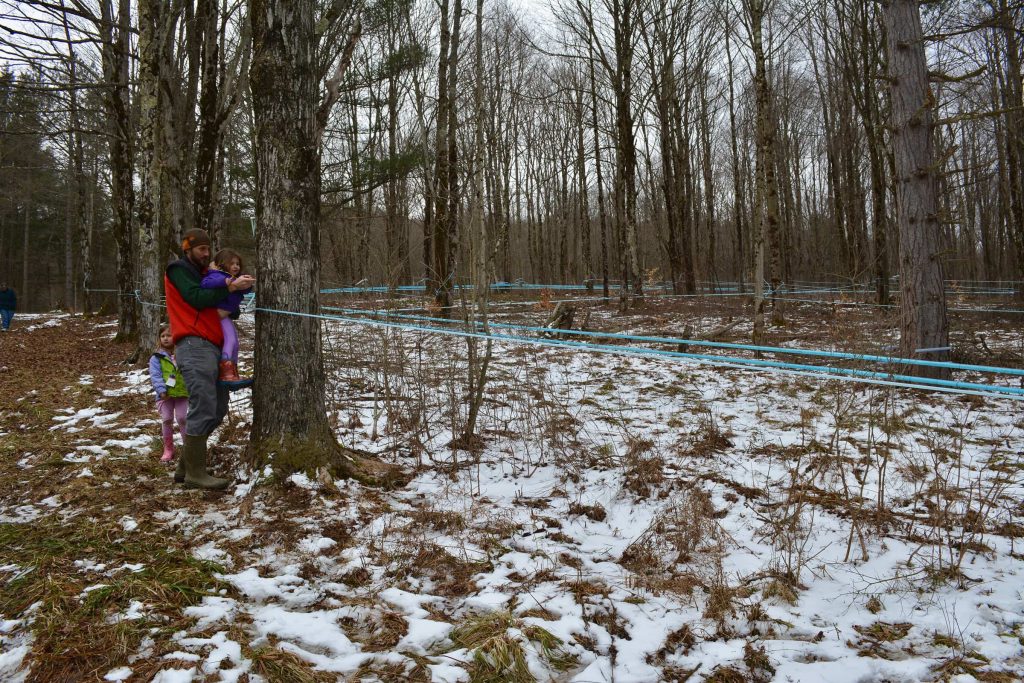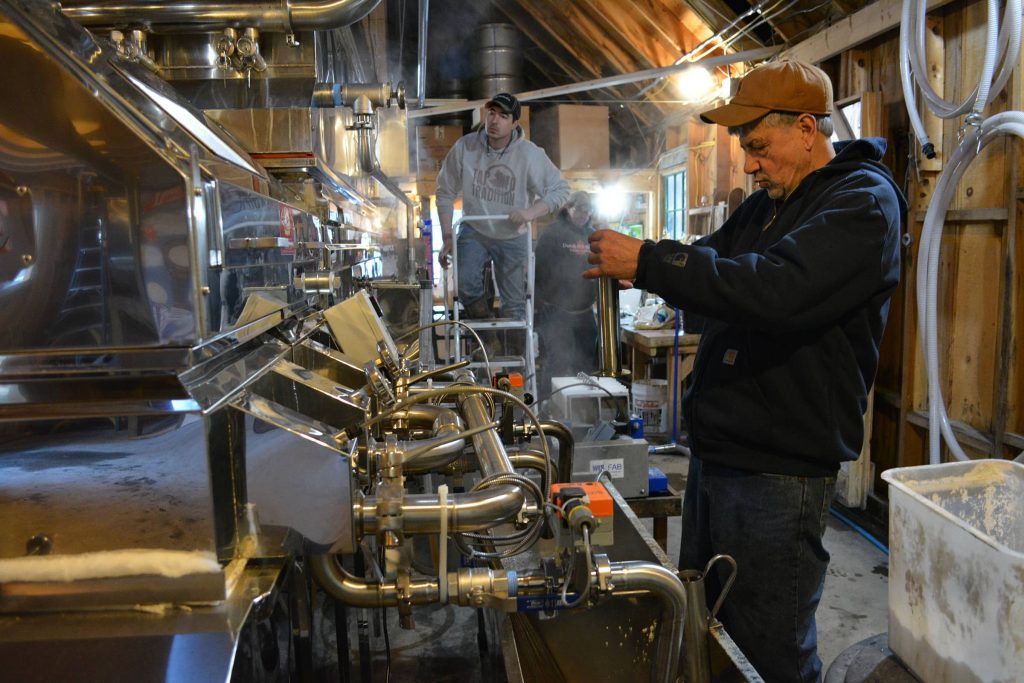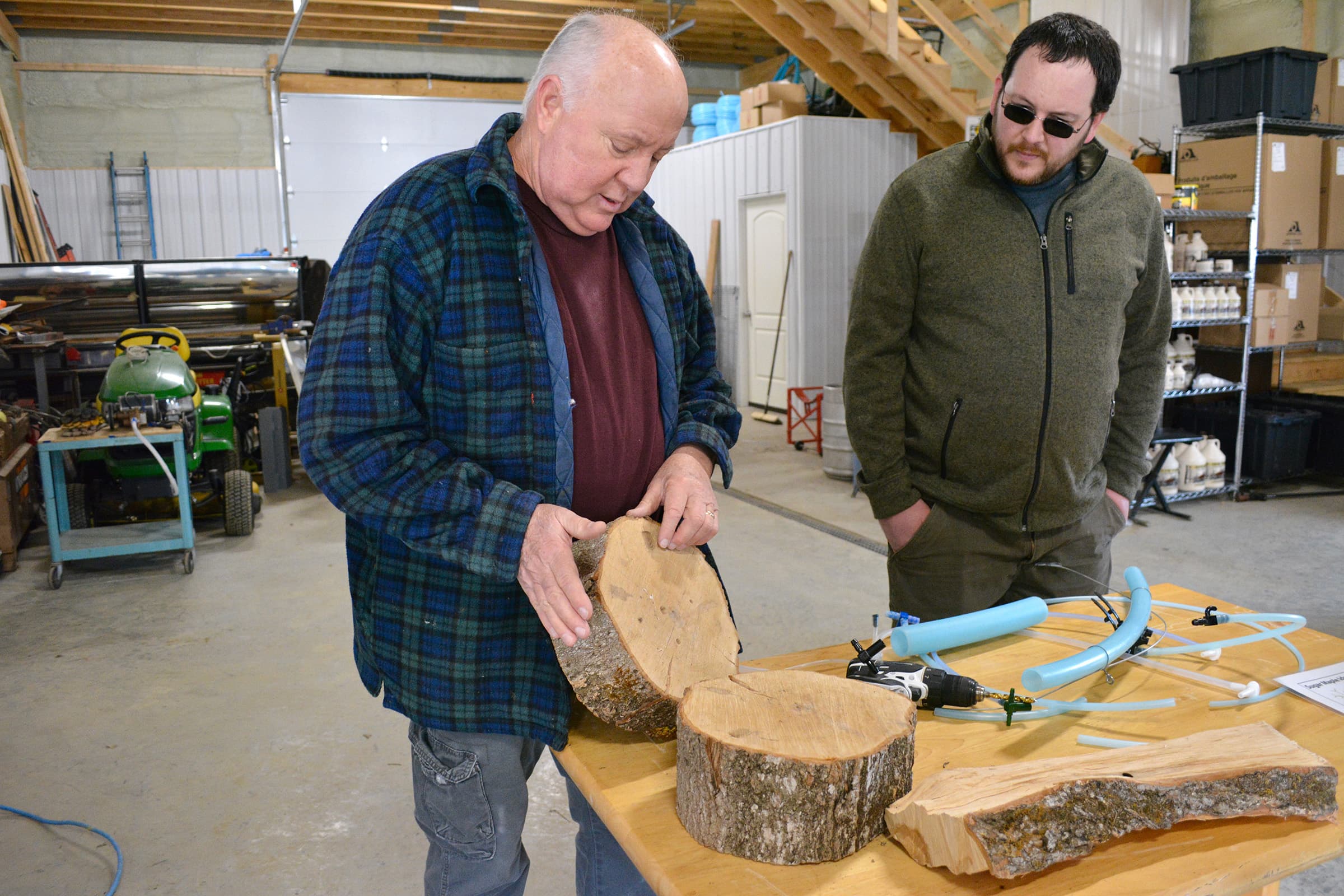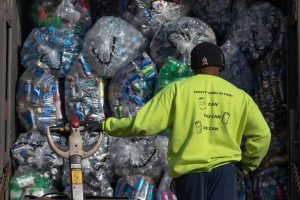Sweetening the climate change deal
Sweetening the climate change deal

When Dan Beasley steps out of his wood-paneled sugarhouse near Ithaca, New York, the subtle smell of sweet vanilla, an aroma universal to maple syrup operations, escapes into the crisp March air. The burly 64-year-old maple producer follows a line of sky-blue tubing blazing the path into his 20-acre forest, abundant with maple trees. As he trudges up the hillside, Beasley’s hiking boots crunch on the patches of frozen mud and snow. A pack of curious locals and their children, here for an annual Maple Weekend event, trail behind, marveling at the endless horizon of trees that supply their go-to pancake topping. One by one, the flannel-clad sugarmaker and his visitors duck under a tube cutting across the footpath. Ten miles of plastic tubing weave through the forest. “When we set up the tubing,” Beasley announces with a grin, “we weren’t drunk.”
The tubing connects 1,600 sugar maples to a system that will carry sap from each tree down to the sugarhouse, where the clear liquid will be transformed into pure maple syrup. Looking down at the SweeTrees Maple forest, the tubing network resembles a map of a city’s roads. Like cars on small streets, sap from each tree courses through a narrow tube into the main line, which spews into the widest line to quickly transport the sugar water to the building.
Surrounded by the crowd, Beasley traces the main line over to a tree and runs his pale hands over the slim tubing. The mossy trunk is just small enough to hug, its thick roots protruding the ground below it. Dime-sized holes from old tap sites freckle the bark that shifts between ashy and deep brown colorings.
“When do you tap the trees?” asks a visitor.
“It depends on the weather,” Beasley says, “which you can’t depend on anymore.”
He moves on to the next stop of the tour and pauses in front of a trunk twice his width, gazing at the remnants of fallen trees that litter the forest floor. “There’s no consistency in anything anymore,” Beasley had said in an earlier phone interview. “That’s the worst thing about it. When it’s hot, it’s too hot. When it’s cold, it’s too cold. When it rains, it rains too hard. When the wind blows, it blows too hard.”
The increasing severity of temperatures and storms isn’t a recent observation for Beasley, either. “There’s something going on with this weather,” he said. “The woman we bought the property from had lived here 80 years, the road washed out once in her memory, and in the last five years, it’s washed out three times. When we get rainstorms here, it ruins the place. We don’t want to turn this into a battle, but something’s changing.”
It’s nearing 11 a.m., and the temperature is hovering around freezing, making it too cold for the sap to flow and syrup to be boiled. But if it rises just a few degrees later that afternoon, Beasley expects to bring in 200 to 300 gallons of sap an hour. At that rate, he’d be able to make about four gallons of deep amber-toned syrup. Compared to the 450 gallons he’d produce this season, today’s yield would be a drop in the bucket.

Nate Williams of Dutch Hill Maple in Tully looks into the evaporator and checks his boiling syrup for foam.

Dave Williams, founder of Dutch Hill Maple, measures the syrup’s density with a hydrometer.
As one of New York’s 2,000 maple producers, Beasley knows that every ounce of syrup is vital. SweeTrees Maple, co-owned by Beasley and his wife Ruth, produces enough syrup to fill 11 bathtubs a season, with each gallon selling for $45 a pop. In 2018, New York sugarmakers produced 806,000 gallons of syrup, breaking a 74-year state record and comprising 19 percent of the nation’s total production. Most people use about one-fourth cup of syrup per three pancakes, meaning New Yorkers could have sweetened nearly 154.8 million pancakes last year alone.
“I always say we put two ingredients in syrup in New York,” says Helen Thomas, executive director of the New York State Maple Producers Association. “We put in sap from the tree, and we put in love.”
This love for maple among producers and eaters is mutual — and deepening. Demand for nutrient-rich syrup has increased among those adopting local and natural eating styles. Coupled with the production surge, this heightened appetite has led to sweet economic benefits for the state: In 2017, New York maple producers brought in $29.6 million in total revenue, nearly double that from the decade prior. The state’s maple industry has grown nearly 50 percent within the last five years, a trend that will be celebrated on August 26 at the 2019 New York State Fair, which declared the date as Maple Day. For now, maple syrup lovers are living in a golden age. But it may not last long.
Sugarmakers are starting to experience the impacts of climate change, which are currently boosting their syrup yield while threatening to destroy their maple trees’ growth rates, ability to produce sap, and habitat. These harmful effects can exacerbate climate change, too: A 25-year-old maple tree can pull more than 2.5 pounds of carbon dioxide out of the atmosphere each year, but slowed tree growth diminishes this amount. With carbon dioxide emissions expected to double in the next three decades, forests are becoming increasingly necessary to alleviate climate change’s impacts. To combat this, researchers and producers are developing and implementing sap collection techniques, production technologies, and maple specialty products, like candies and creams, to offset potential climate-related losses. And with government-sponsored programs pushing for environmentally sustainable production practices, dry pancakes won’t be a problem just yet.
Sugarmakers will likely continue filling more syrup jugs and breaking long-standing records, a symptom of three industry-wide changes, Thomas says. “It’s the better techniques, it’s more taps — just about everybody I know adds a few hundred taps each year, or a couple thousand — and there are a few new producers this year,” she says. “I think the majority of the increase in production is due to technique and technology.”
Thanks to new maple sap harvesting technologies and better sanitation practices, sugarmakers have been able to significantly increase sap yield per taphole, adds Timothy Perkins, director of the Proctor Maple Research Center at the University of Vermont. These techniques also extend the season’s length, Perkins says in an email, which has already been prolonged by more frequent warm spells earlier in the winter; in 2018, the New York season started 18 days earlier, and closed 8 days later, than in 1988. “When I was a kid, my dad said, ‘You don’t tap until March 15,’” Thomas says. “For the last 10 years, our season is almost done by March 15.”
Rising winter temperatures are double-edged; as producers reap the economic benefits of the earlier tapping dates, climate change threatens their long-term production and viability. Since 1968, winter temperatures in the northeastern United States have increased an average of 0.7 degrees per decade. Cold temperatures are needed to encourage sugar formation within the tree’s stems. Once spring begins, sap flow relies on cycles of freezing nights, during which sap is pulled up from the tree roots, followed by warm days that push sap down from the branches and out the taphole. With warmer winter temperatures, the sap’s sugar content is likely to decrease. With fewer freeze-thaw cycles, maple trees generate less sap overall. Taken together, these effects may diminish the amount of syrup sugarmakers can produce.
As the weather grows warmer and the optimal climate for sugar maples moves northward, experts project the amount of habitat for sugar maple trees in the United States will shrink by the end of the century, according to a 2018 University of Massachusetts study. An additional five million taps will be needed to maintain 2012 syrup production levels, with New York requiring 600,000 of those taps. The prognosis for southern producing states is most grim: Sugarhouses in Virginia and Indiana are expected to experience a 28 to 52 percent drop in total sap collected within the next eight decades. Sap sugar content has also been projected to decrease throughout the country, with 21 to 27 percent declines, leading to a plunge in syrup production per tap.
“If it continues to get warmer… [producers] could not get the good, long extended freezes and good cold periods that are beneficial to the trees,” says Adam Wild, director of the Uihlein Maple Research Forest, which is part of the Cornell University Maple Program. “That could impact the overall long-term health of the tree. It could really shorten seasons — instead of having a good four to six weeks, we might only have a couple weeks in the season.”
Sugarmakers like Beasley are adapting to the warming climate and striving for an eco-friendly production process from tree to bottle. The producer got his first taste of syrup production when he was just a tyke, helping his hobbyist grandparents make syrup at five years old. After a 41-year career at a railroad company, he jumped back into sugarmaking. In 2004, Beasley, Ruth, and their children stuck three spouts into a maple tree and let mother nature work her magic, collecting the sap in metal buckets. Without an evaporator to transform the sap into syrup, the family needed to get creative: Their first batch was boiled in a turkey fryer, using 40 gallons of propane to make one gallon of syrup. Fifteen years later, the sugarmakers are just as innovative, but they’ve abandoned the energy-draining techniques to become model environmentally sustainable syrup producers. Each season, they modify their business to become even greener.
“Mother Earth is taking good care of us, so we should care for the earth,” says Ruth. “Using these technologies is one way we can try to do that. She’s given us our yummy syrup, so we should give her something back.”
With each tap placed, gallon of sap collected, and barrel of syrup produced, the Beasleys keep the long-term health of their maple forest, known as a sugarbush, in mind. Cornell University’s Maple Program recommends tapping a maple tree only when it’s at least 10 inches in diameter, and though the SweeTrees sugarbush has trees with diameters larger than 18 inches — the suitable size to add a second tap — the producers won’t add more than one. Adding extra taps would double production, Beasley says, but they want to keep these small punctures to a minimum in hopes of keeping the tree as healthy as possible.
Producers are also encouraged to engage in sustainable forest management, or tending to their forest for current and future productivity. Incorporating tree species other than maple into a sugarbush can boost its immunity to pest outbreaks, and maintaining tree age and height diversity can create habitat for different birds and mammals, says Aaron Wightman, a maple specialist at Cornell University’s Maple Program. Removing less healthy trees and thinning the forest can help, too, as a larger canopies and trunk sizes are generally linked to increased sap production and higher sugar content. “We’re trying to maintain the sugarbushes in perpetuity,” Wightman says. “If we create conditions that are unhealthy for the trees, we’re gonna lose our sugarbushes, and it takes a long time to grow a new one.”
It can take up to 50 years for a sugar maple tree to reach 10 inches in diameter, a stretch of time that climate change is threatening to extend. Most maple trees in the northeastern United States rely on an annual covering of snow to prevent the soil from freezing, which can damage tree roots. In a 2018 City University of New York study, researchers found that warming winter climates and reduced snow in the early winter months can cause the frost to extend deeper into the soil and last longer, slowing maple tree growth by up to 40 percent. Stunted growth can also diminish the amount of atmospheric carbon dioxide the forests capture and store by 8.8 percent — a drop that curtails the sugarbush’s ability to mitigate the impacts of climate change. Considering the worst-case greenhouse gas emission scenario, the experts project the area of northeastern forests typically experiencing insulating snowpack will shrink by 95 percent by the end of the century, from 33,000 square miles to 2,000.
Since the 1960s, maple producers have been adopting innovative technologies to minimize their environmental impact and energy use. As the technology grew cheaper, environmentally sustainable production became possible for everyone from backyard producers to owners of mid-sized operations, like Nate Williams.
On a 45-degree March evening, Williams strides through Dutch Hill Maple’s sugarhouse in Tully, New York, overseeing each step of the mechanical syrup production process. The 31-year-old producer follows the maple sap as it depletes the 4,000-gallon holding tank and flows through the plastic tubes that line the ceiling into the reverse osmosis machine. He throttles the stream of diluted sap pouring into the contraption, concentrating the liquid to 10 percent sugar content, and watches it rush into the next set of pipes. The sap arrives in the stainless-steel evaporator, reducing it into sweet syrup, and Williams lifts open the machine’s hatch, scanning for any sign of unwanted foam. Moments later, he steps over to the evaporator’s mouth and gleefully watches the unrelenting waterfall of fresh, amber-toned maple syrup cascade into a metal trough. In an hour, the 6,200-tap operation produced 80 gallons of buttery syrup, just a fraction of Williams’ 3,000-gallon goal. “We’re on our way to reaching it,” Williams says. “But nature could turn it off tomorrow.”

On average, a sugarmaker needs 43 gallons of sap to produce one gallon of syrup. To boost efficiency, an estimated 80 percent of commercial sugarmakers turn to reverse osmosis machines, which pump sap through a series of membranes and remove at least 75 percent of the liquid’s water content before sending it to the evaporator. Boiling time is cut by 50 to 75 percent, and fuel consumption is reduced, too. When the family of sugarmakers at Dutch Hill Maple — co-owned by Williams, his wife Cristy, and his father Dave — used a wood-fired evaporator to boil their syrup, the process took at least 12 hours. Last year, the producers secured a United States Department of Agriculture grant to foot half the bill of a new reverse osmosis machine and oil-burning evaporator. The $86,000 purchase cut their carbon dioxide emissions by 72 percent, and they’re able to boil the same amount of sap in just two hours, Williams says.
Like the Williams family, the Beasleys embrace eco-friendly, and cash-saving, technology. With their eight-year-old reverse osmosis machine, the duo produces six times as much syrup on the same amount of fuel. Since their first year in production, they’ve adopted four energy-efficient evaporators, each one more advanced than the next. The Beasleys’ newest model, now on its second season, uses scrap wood pellets from trees that have already been cut for furniture. The sugarmakers also take advantage of a renewable, cost-free energy source: the sun. In 2014, a 20-panel solar collector was installed next to the sugarhouse, the $20,000 cost supported by grant funding. On a sunny day, the collector can produce 5,000 watts of energy, keeping their monthly energy bill at roughly $15.
The adage “leave it better than you found it” is at the core of the maple industry, says Wightman. Thomas estimates that 90 percent of maple farms in New York are generational, and they often work land that’s been in the family for ages. Since producers often want to continue passing the sugarbush down the line, there’s a lot of awareness about the importance of maintaining the forest health, Wightman adds.
Although the Beasleys’ children aren’t vying for the family business, and Williams’ nine-month-old daughter has a few decades to decide if she’d like to carry on Dutch Hill Maple, both families are driven to maintain a healthy sugarbush to benefit the generations — of maple trees and maple producers alike — to come. “Things that we do, like thinnings, that’s all for the future,” Williams says. “It’s not so I can see the benefit today or tomorrow, it’s 20 years down the road — that’s when you’re going to notice the real change in doing that thinning and forest management.”
Despite producers’ commitment to using green technologies and sustainable forest management practices, the threat of climate change and its forthcoming negative impacts still loom. The Beasleys used to travel in January, but with the increasingly inconsistent winter temperatures and earlier warm spells, they now have to tap the trees before mid-February or risk missing out on valuable sap flows. And just as a bloody skin scrape will eventually scab over, a sap-oozing taphole will close. The earlier in the season a tree is tapped, the earlier in the season the hole could close, potentially causing producers to miss good sap runs from the favorable weather later in the season, resulting in less syrup produced.
That’s the climate change-related problem Steve Childs is trying to tackle as the New York State Maple Specialist and Director of Cornell University’s Maple Program. Childs has been working in the industry since the 1970s, a time when it was rare to see any syrup weather in January and February, he says. Last year, the Cornell team made half its crop in February. Since every season’s temperature patterns differ, he’s developing sanitation techniques that can help keep the tapholes open longer, prolonging the sap flow season.
When the temperature rises above freezing, the tree develops a positive pressure and pushes sap out the taphole. When the temperature dips below freezing, the tree forms an internal vacuum and pulls sap back from inside the plastic tubing that funnels it to the sugarhouse. But if the tubing isn’t sterilized, this suction can bring lingering bacteria and yeast into the taphole, which will gradually plug it, Childs says. Childs found that soaking the spout and drop line in bleach for 30 minutes before installing them each season is most effective in prolonging the taphole’s life and, ultimately, production. “That seems to be a major improvement without creating big piles of plastic,” he says. “When you put new spouts and drops out there, you have to throw out all the old ones.”
During the 2018 season, Childs and his fellow researchers put this method to the test, tapping the trees at Cornell’s Arnot Research Forest in mid-January. The tubing networks that had sanitation systems in place achieved sap flow until April 24, while those without shut down three weeks prior. Without these techniques, producers would have to re-tap their trees once a taphole closes — a process that comes with a cost. To get sap flow, producers have to tap at least six inches above or below old holes. When a sugarmaker double taps every year, they exhaust the trees’ clean, white wood too fast for sustainable tapping, Childs says.
Despite any issues resulting from the weather, Childs says these sanitation practices and the use of improved vacuum pressure systems, which pull more sap out of trees even at temperatures slightly too cold for sap to normally flow, have helped increase productivity. In 2008, when vacuum pumping systems began to replace bucket collection methods, New York sugarmakers produced an average of 0.218 gallons of syrup per tap. A decade later, their yield per tap grew by 35 percent, amounting to more than a quart of syrup. “I would say that we would have climate change beat right at the moment,” Childs says. “We’ll see what the future holds.”
Maintaining the maple industry’s prosperity doesn’t solely entail increasing production. With long-term viability in mind, maple needs to be sustainably produced, and a market for the surging amount of syrup has to exist. The solution: the New York State Grown and Certified program. The marketing and labeling campaign, launched in 2016 by Governor Andrew Cuomo, seeks to help more than 2,300 agriculture producers throughout the state capitalize on the growing market for locally made, high-quality foods. With the initiative’s stringent requirements on producers, consumers become confident in the practices used to produce the foods they put on the table. The program was extended to include maple in February 2018, with 14 sugarmakers blazing the trail, and by April 2019, 44 other producers joined, including Dutch Hill Maple.
Alongside following food safety best practices and sourcing from trees within the state, the program requires producers to keep the well-being of the environment in mind: Maple producers must have certification from one of three agriculture or forest management programs, proving their commitment to sustainability. While the Pride of New York program had a similar goal of aiding producers, Beasley, who joined Grown and Certified its inaugural year, says it was a joke; producers would pay a one-time fee to become certified, with no requirement of abiding by certain standards, he says. Yet, the fresh program’s criteria have made the owners of SweeTrees Maple hopeful of its longevity. “It gives more credence to us as a small business that we’re part of something a little bit bigger,” Ruth says, “that we did a little more work to ensure the quality of our product.”

For Lyle Merle, this dedication to producing first-rate maple products extends beyond syrup itself. The 64-year-old owner of Merle Maple produces 8,000 gallons of syrup on his 18,000-tap operation in Attica, New York, with more than half of his yield being sold under Wegmans’ private label. Rather than relying solely on syrup sales, Merle, a fourth-generation sugarmaker, diversifies his revenue streams by constantly creating new maple specialty products. Featuring untraditional condiments like bourbon maple spread, maple mustard, and maple hot sauce, the product line is the most expansive in the state, he says. “You gotta get out of the mindset that it’s just for pancakes,” Merle says.
The fan favorite: maple candy. Each season, Merle transforms 1,600 gallons of syrup into sugar candy, which retails for $20 a pound. While he’d earn only $59 for a gallon of pure syrup, the sugarmaker can bring in about $140 in one gallon’s worth of candy. Like Merle, Williams is working to grow Dutch Hill’s collection of maple confections, which make up about 60 percent of the company’s sales, he says. The sugarmaking family makes maple cotton candy and seasoning and is currently developing a syrup-infused barbecue sauce. These value-added products can prevent the market from becoming oversaturated with syrup, which would force sugarmakers to become giant producers, making profits based on volume, or go out of business, Wightman says. More significantly, creating innovative products and finding new markets can buffer the industry from the negative effects of climate change, according to the Northeast Climate Science Center.
Back in his sugarhouse, Beasley weaves in and out of throngs of folks chatting over steaming cups of maple coffee and nibbling on bite-sized pieces of maple candy. The six-foot-long evaporator takes up a third of the room, serving as the sugarhouse’s centerpiece and the focus of the two dozen Maple Weekend visitors’ conversations. A trio of pre-teens squeezes themselves between the shiny machine and a folding table laid out with the extensive spread of sweet samples. One by one, the girls hold out their taster spoons for pumps of amber syrup, pop the plastic in their mouths, and grin as the vanilla flavor hits their taste buds. They contemplate their next pick and hold out their dainty palms for bits of maple peanut fudge and maple-coated cashews.
Beasley’s son mans the bottling machine, filling pint-sized jugs with piping hot syrup. The sugarhouse is already abundant in the liquid gold: Across the room, wire racks support assorted sizes of syrup containers. Near the checkout counter, granulated sugar shakers and maple candies are arranged in neat rows. A father hands over a few bills to the cashier to cover the cost of a golden maple leaf lollipop, which his daughter already has unwrapped, and motions the young girl toward the door. As they step outside and onto the edge of the forest, Beasley is trekking back into his sugarbush with another tour group, ready to share how he collects the sap that supports his livelihood and supplies their favored pancake topping once again.





